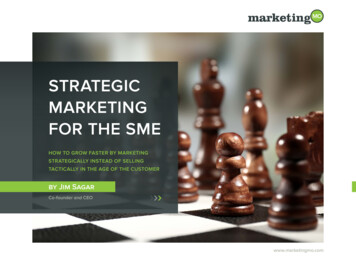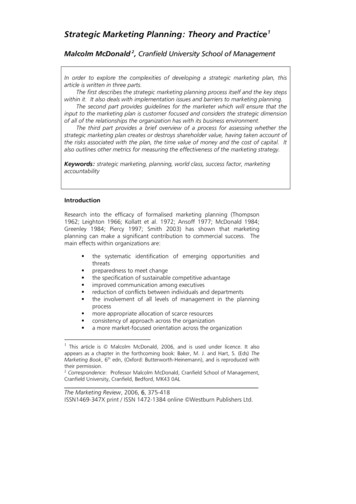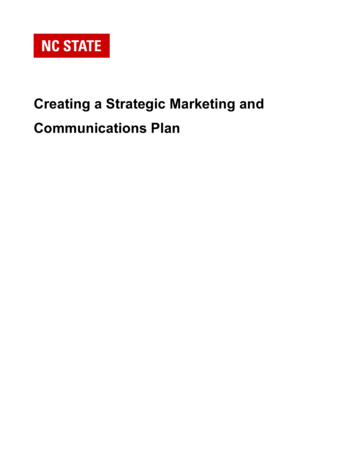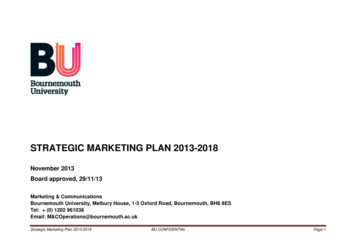
Transcription
STRATEGICMARKETINGFOR THE SMEHOW TO GROW FASTER BY MARKETINGSTRATEGICALLY INSTEAD OF SELLINGTACTICALLY IN THE AGE OF THE CUSTOMERby Jim SagarCo-founder and CEO›››www.marketingmo.com
SUMMARYWHO IT’S FORToday, many CEOs, owners and executives of small to midsizeenterprises (SMEs) are struggling with growing their company.There’s concern about how the marketis changing. People no longer trustcompany-sponsored advertisements.Digital media presents a dizzying array ofchoices for reaching customers who arebecoming harder to influence.The solution isn’t a new marketingtactic or social media channel or to “sellharder.” The solution is to understandhow to communicate strategically withyour market, to connect with peopleemotionally and to influence their behavior.Today is a new paradigm—the Age of theCustomer. Those who “get it” are growingfaster than ever. Never before have somany companies gone from startup toa billion-dollar valuation so quickly.IT’S ABOUT MARKETINGBut those who don’t are struggling" "andare in danger of being left behind.Share:fliThis guide is designed for the CEO,owner and key executives of a smallto midsize enterprise (SME for short)and is a 20-minute read.The Strategic Marketing Roadmapand content can be used by yourteam throughout the year.STRATEGICALLY INSTEADOF SELLING TACTICALLY.This guide explains why the typical SMEstruggles to grow in today’s marketplaceand presents a Strategic MarketingRoadmap that will enable you and yourteam to create an emotional connectionwith your market, stay relevant, and thrive.2 38ACCESS course materials that guide you through eachstrategic elementstrategy.marketingmo.com
ABOUT THE AUTHORJim Sagar is a management consultantand entrepreneur focused on aligningstrategic marketing and sales in thesmall to midsize enterprise. He currentlyserves as the co-founder and CEO ofMarketing MO and is a co-founder andBoard of Directors member of Medelis,a biotech and pharmaceutical servicescompany founded in 2003.Jim works directly with the leadership teamsof small to mid-market enterprises. Hiscompany’s website at MarketingMO.comprovides step-by-step self-guidance forstrategic and tactical marketing initiatives toover 50,000 businesspeople each month.In addition to Strategic Marketing for theSME, he is the co-author of two businessbooks with a focus on aligning marketingto business strategy. He holds degreesin Economics and Communications fromthe University of Michigan.Share:fli3 38ACCESS course materials that guide you through eachstrategic elementstrategy.marketingmo.com
Copyright Moderandi Inc. 2016. All rights reserved.No portion of this publication may be reproducedin any form by any electronic or mechanical meanswithout written permission from Moderandi Inc.›››
CONTENTSI.STRATEGIC MARKETING—A MYSTERY IN THE SME6“Marketing” Redefined8Strategic Marketing—An ExampleHow the Non-Strategic CommunicateII. TODAY’S PARADIGM—THE AGE OF THE CUSTOMERIV. A STRATEGICMARKETING ROADMAP1.91012III. HOW MOST SMES APPROACHTHE MARKETING FUNCTION162.Inspire22Purpose23Core Values24Buyer Personas and Their Inspiration25DifferentiatePositionDesired Mindshare4.5.DefineShare:fliExpanded Roadmap Guidance3637372828292930Brand Means30Brand Positioning Statement31Brand Experience31ImplementVI. ADDITIONAL RESOURCES3526Brand Personality TraitsAuditMeasurement and Refinement26Brand StoryInitiatives6.22Why, How, What CommunicationCompetitive Advantages3.19V. EXECUTIONOF YOUR STRATEGY323233Brand Vision33Big Idea34Tactics34ACCESS course materials that guide you through eachstrategic elementstrategy.marketingmo.com
I.Customers are thelifeblood of a business.Every successful entrepreneurunderstands how to acquireand maintain a customer.STRATEGIC MARKETING—A MYSTERY IN THE SMEIn startups and early-stage companies,the founders often handle these activities.They’re passionate. They care. They wantthe customers. They need the customers.Without them, their business fails.Yet as companies grow, the process ofacquiring and maintaining customersbecomes more complicated. Morepeople are hired and participate in theprocess. Messages change. Productsand services evolve. The customerbase evolves. New competitors emerge.The sales team evolves.And at some point, the growth stops andSMEs get stuck. (When we use the term“SME,” we’re typically referring to companieswith revenues of 1 million to 100 million).Share:fli6 38Fortune 500 companies and consumerproduct marketers almost always devotesignificant resources to marketing theirproduct or service. They typically spenda far greater percentage of their budgetthan SMEs on things like: Market research Competitive positioning Brand strategy Market trends Buyer psychology Behavioral economics DistributionACCESS course materials that guide you through eachstrategic elementstrategy.marketingmo.com
From my and my colleagues’ experienceworking with over 1,000 SMEs in the UnitedStates, Canada, Australia and the U.K.,we found that the #1 difference betweenFortune 500 companies and SMEs is inhow they acquire and maintain customers: The Fortune 500 lead with strategicmarketing instead of tactical salesImbalanceMarketingSales SMEs lead with tactical salesinstead of strategic marketingThe sales function is the endpointof the marketing process—wherea customer makes a purchase ornon-purchase decision. Leading withtactical sales creates an imbalance inthe entire marketing function—you’reputting tactics before strategy in thecustomer acquisition process.It’s backward. And it prevents manySMEs from growing and realizing thevision of their founder.Share:fli7 38ACCESS course materials that guide you through eachstrategic elementstrategy.marketingmo.com
“MARKETING” REDEFINEDThe first step in correcting thisimbalance is to redefine how you viewthe term “marketing.”So why is it so common for manystakeholders of SMEs to devaluethe marketing function?In many SMEs, the word “marketing”has a negative connotation.It’s difficult to value what you don’tunderstand. And most SMEs don’tunderstand strategic marketing becausethere’s little to no strategic marketingexperience within the company. Thepeople trained in strategic marketingwork at big companies and agencies.It’s treated as an expense instead ofan investment. It’s used as a stopgapto generate leads when the sales teamstarts missing its numbers. It’s typicallyowned by the VP of Sales (who is trainedin sales, not marketing). And when timesget tough, it’s one of the first budgets toget cut (when it should be increased!).Marketing is rarely valued by executivesin the typical SME.Yet executives in Fortune 500 companies,along with influential businessconsultants, have the opposite viewof the marketing function.The late Peter Drucker, considered thefather of business consulting, long agomade a very profound observation:BECAUSE THE PURPOSE OF BUSINESSIS TO CREATE A CUSTOMER, THEBUSINESS ENTERPRISE HAS TWO—So when the CEO and other SMEstakeholders plan for growth, they almostalways default to what they know best(tactical sales) instead of what is neededmost (strategic marketing).AND ONLY TWO— BASIC FUNCTIONS:MARKETING AND INNOVATION.MARKETING AND INNOVATION PRODUCERESULTS; ALL THE REST ARE COSTS.MARKETING IS THE DISTINGUISHING,UNIQUE FUNCTION OF THE BUSINESS.Share:fli8 38ACCESS course materials that guide you through eachstrategic elementstrategy.marketingmo.com
STRATEGIC MARKETING—AN EXAMPLESince strategic marketing is a mystery formost SMEs, it’s helpful to see an exampleof a well-executed marketing strategy.RACKSPACE IS A MANAGEDHOSTING COMPANYFOUNDED IN 1998 BY THREECOLLEGE STUDENTS.They started with a small amount ofventure funding during the early daysof the Internet. Rackspace’s offering,at the simplest level, was renting outhard drive space on their computers toother companies to host their websitefiles. And there were plenty of othercompanies doing the same thing. Theyhad a commodity-like offering.Share:fliThe Rackspace founders made a keystrategic decision early on that hada dramatic impact on their company.Instead of talking about the size of theircomputers or the speed, or the uptime"—the things that most of their competitorswere talking about—the stakeholdersdecided to talk about something else.9 38They decided to focus their entirecommunication platform on the conceptof Fanatical Support. They defined it,built it into their processes, promisedwhat they’d deliver, managed theiremployees around it, and deliveredit to the marketplace.ACCESS course materials that guide you through eachstrategic elementstrategy.marketingmo.com
Rackspace stakeholders took a simpleidea and used it to create a unique andunified brand experience through alltouchpoints with their market.That is strategic marketing, and itwas a major driver of their growth toa 1.6 billion public company in 2016.After 17 years in business, it’s still a centralfocus of their communications platform:EVERY RACKSPACE EMPLOYEE (A.K.A.“RACKER”) IS DEDICATED TO DELIVERINGFANATICAL SUPPORT, NO MATTER HOWLARGE OR SMALL YOUR ORGANIZATION.HOW THE NON-STRATEGIC COMMUNICATETo some, the concept of providing greatcustomer support might not seem creative.When polled, many CEOs of SMEsthink that their company provides greatcustomer service1. But few of them chooseto communicate it like Rackspace does.And since they don’t communicate it ina way that differentiates them and makesan emotional connection with their buyer,it doesn’t become an essential part oftheir brand or a competitive advantage.THE FANATICAL JACKET AWARD IS GIVENTO RACKERS WHO’VE GONE ABOVE ANDMost typical stakeholders of SMEscommunicate in a more straightforwardmanner. They talk in a linear fashion,explaining what they have, how it’s better,and why people should buy from them.This sounds like rational and logicalthinking. But the growing field ofbehavioral economics is showing thatbuyers don’t make rational and logicaldecisions. People make emotionaldecisions driven by the biology of ourbrain and psychology (even when makingbusiness-to-business buying decisions).Here’s an example:BEYOND—PUTTING THEIR EXPERTISE ANDCREATIVITY TO WORK BUILDING THE FINEST›››“DO-IT-TOGETHER” MANAGED CLOUDEXPERIENCE FOR OUR CUSTOMERS.1 Jaynie Smith, Creating Competitive Advantage: GiveCustomers a Reason to Choose You Over Your Competitors (Crown Publishing Group, 2006)Share:fli10 38ACCESS course materials that guide you through eachstrategic elementstrategy.marketingmo.com
RCA LYRA RD2201ARCA created a very slick MP3 player in1999. It came with a 32MB CF card. RCApromoted it by talking about its technicalspecs and performance. The Lyra wasconsidered to be a good product andsold well in the late ’90s.APPLE IPOD “1,000 SONGS IN YOUR POCKET”A few years later, Apple came out with their own version of the MP3 player, the iPod,which did the same thing. But instead of trying to emphasize how and why the iPod wasbetter than the Lyra, Apple chose to focus on making an emotional connection with theirbuyer. Apple knew that emphasizing features and technical specs wouldn’t get peopleexcited. But having 1,000 songs in your pocket? That got people excited.STORAGE FOR 1GB OF MP3S1,000 SONGS IN YOUR POCKETVSShare:fli11 38ACCESS course materials that guide you through eachstrategic elementstrategy.marketingmo.com
II.Making an emotionalconnection with your buyeris more important today thanit was when the iPod came out.TODAY’S PARADIGM—THE AGE OF THE CUSTOMERDigital marketing, social media and mobiledevices have dramatically changed howwe connect with our audiences. They’vecreated a tremendous opportunity, as wellas a tremendous burden.It’s more important than itwas even five years ago.INSTEAD OF HAVINGA HANDFUL OF CHANNELSTO CONSUME INFORMATIONAND CHOOSINGWHEN TO CONSUME IT(E.G., TV, RADIO, SALESREPS, PRINT ADVERTISING),PEOPLE TODAY ARECONSTANTLY BOMBARDEDWITH MESSAGESAND DATA ALMOST“EVERY TWO DAYS WE CREATE AS MUCHINFORMATION AS WE DID FROM THEDAWN OF CIVILIZATION UP UNTIL 2003.”—%E RIC SCHMIDTFORMER CEO OF GOOGLE8/4/2010Stop and think about that quote fora minute. Think about your parentsand your grandparents and theirability to access information. Somehave suggested that today we areexposed to more information in oneweek than our great-grandparentsconsumed during their entire lifetime!On a daily basis, we’re inundatedwith over 5,000 brand exposures.Only 12 engage us.EVERY WAKING HOUR.Share:fli12 38ACCESS course materials that guide you through eachstrategic elementstrategy.marketingmo.com
AVERAGE NUMBEROF ADVERTISEMENT ANDBRAND EXPOSURES PER DAYPER PERSON: 5,000 AVERAGE NUMBEROF “ADS ONLY” EXPOSURESPER DAY: 362All of this digital communication ishaving an effect on our attention span.Texting and Twitter have conditionedus to shorten our communicationfrom lengthy sentences in emails toa maximum of 140 characters.If 140 characters are too many, peopleuse the single-phrase #hashtag.Teenagers communicate via text usingemojis (pictures) instead of words.AVERAGE NUMBEROF “ADS ONLY” THATMADE AN IMPRESSION(ENGAGEMENT): 122All of this communication is overwhelming.As a defense mechanism againstinformation overload, our mind screensand rejects most of the informationoffered to it. We create “ladders” in ourmind (like buckets to organize things,with a ranking system in each one),quickly deciphering what something is,on which ladder it should be placed andwhere on the ladder it should be ranked.Nonessential information is filtered out.The more information we receive, themore gets screened and avoided.This has created today’s paradigm: People research online before buying2 Sheree Johnson, New Research Sheds Light onDaily Ad Exposures, SJ Insights, s-light-on-daily-adexposures/Share:fliIn 2000, Microsoft Advertising completeda study to determine that the averagehuman attention span was 12 seconds.By 2013, it was only 8 seconds. And theattention span of a goldfish is 9 seconds.13 38 People no longer trust companysponsored advertisements We’re connected to the Internet24/7 via our mobile devicesACCESS course materials that guide you through eachstrategic elementstrategy.marketingmo.com
Owning a clear spot on a ladder (whichrepresents a category) in your customer’smind is more important today than everbefore. Today is the Age of the Customer.The people control your brand.In B2B, this means that brands are beingevaluated and screened before the salespeople ever get a chance to influencea prospect. In some industries, buyerscontrol up to 70% of the buying process—control that sales teams used to have.The conversation and brand interactionsare happening without your sales team.Buyers today have access to almostall of the information they need at theirfingertips. Since they have so manychoices, most default to the brands thatcreate an emotional connection.Share:fliIf your company understands this andis successfully making that emotionalconnection, you’re probably experiencing: Rapid growth Inquiries where the potential buyerhas already decided that you’re oneof the leaders in the category Inquiries with specificbuying questions—aboutthe use of your offeringIf you’re falling behind, you’re probablyexperiencing: Flat sales, or slow growth thatrequires substantial effort A small percentage of salesfrom new inbound leads Sales cycles that are led bythe sales team, who have to forcebuyers through to the next step Sales cycles that are led by the buyer Substantial educational effortsduring the sales cycle People sharing their experience withyour brand, both online and offline Prospects focusing on your price,treating you like a commodity Few people talking about your brand,either online or offlineThis will only become more prevalent inthe coming years. If you’re falling behind,your brand will be at risk in the near future.14 38ACCESS course materials that guide you through eachstrategic elementstrategy.marketingmo.com
Share:fli15 38ACCESS course materials that guide you through eachstrategic elementstrategy.marketingmo.com
III.Since the purpose of thisguide is the show SMEHOW MOST SMESAPPROACH THE MARKETINGFUNCTIONIn the graphic below, potential customers in the marketplaceare at the top and the sales tactics are on the bottom.stakeholders how to marketMARKETstrategically instead ofgrowing through tactical sales,let’s start by examining howthe typical SME approachesthe process of acquiring andmaintaining a customer.TYPICAL APPROACH LEADING WITH SALES TACTICS ON A ONE-TO-ONE BASISSALES TACTICSShare:fli16 38ACCESS course materials that guide you through eachstrategic elementstrategy.marketingmo.com
Most SMEs focus on connecting withindividuals in their market on a one-to-onebasis. Sales reps make new connections,generate new conversations and attemptto persuade people to become a customer.When done well, this can be an effectivemethod for growth, albeit a slow one;since it’s incremental, it’s difficult to achieverapid growth. If the sales operation isn’tefficient, customer acquisition costsincrease and margins decrease.SEGMENTSA SLIGHTLY BETTER APPROACH BASED ON MARKET SEGMENTS,AKA “BUYER PERSONAS”Some SMEs take an incrementally betterapproach by focusing on communicatingwith their buyer personas (market segments) instead of on a one-to-one basis.This is represented in the second graphic.It’s smart to structure communication toappeal to buyer personas.Share:fliSALES TACTICS17 38ACCESS course materials that guide you through eachstrategic elementstrategy.marketingmo.com
SEGMENTSTHE TRUE STRATEGICAPPROACH FOCUSES ONLEADING WITH A UNIFIEDBRAND EXPERIENCE, WITHALL TACTICS ALIGNED TO IT.THIS IS RARE IN THE SME.THE STRATEGIC APPROACH LEADS WITH A UNIFIED BRAND EXPERIENCEAND ALL TACTICS ALIGNED TO ITSo what does this unified brandexperience look like? How do youdesign it? And how do you execute itwith the typical resource constraintsof the small to midsize enterprise?STRATEGICMARKETINGSALES TACTICSShare:fli18 38ACCESS course materials that guide you through eachstrategic elementstrategy.marketingmo.com
IV.Delivering a consistentand repeatable brand experienceat all market touchpointsrequires a significantamount of planning.A STRATEGICMARKETING ROADMAPTo simplify, it is helpful to have a roadmap.THERE ARE NUMEROUSSTRATEGY WORKFLOWS THATFORTUNE 500 COMPANIESAND BIG AGENCIES USE,BUT MOST SMES HAVELIMITED BANDWIDTH ANDNEED SOMETHING MORETANGIBLE AND DETAILEDTO JUSTIFY THE EFFORT.On the next page is the StrategicMarketing Roadmap that we’ve developedthat organizes all of the key elementsof a long-term marketing strategy. Itis designed to deliver a unified brandexperience to the marketplace that makesan emotional connection with your buyers.Share:fli19 38It is important to note that after reviewingthe Roadmap, many of the elements maylook familiar to you. They should.The components of strategic marketingare not new. You’ve heard of some"—or many—of these components before.Some have been used by Fortune500 companies for 50 years.What is new is that our Roadmap showsyou how they fit together, and how toapply these to your small to midsizeenterprise. This is what we’ve compiledfrom our 20 years of experience.To some, this roadmap may lookintimidating. As I mentionedearlier, strategic marketing is oneof the least understood businessfunctions in the typical SME. Don’texpect to master it overnight.ACCESS course materials that guide you through eachstrategic elementstrategy.marketingmo.com
And understand that strategic marketingis not necessarily about finding thecatchiest slogan or the most creativeidea. While creative people do playa role in delivering this brand experienceto the marketplace, defining the coreelements of what the brand stands for isthe responsibility of the stakeholders ofthe SME—the owners, key executivesand the CEO. And in most instances,the CEO must champion it.Strategic marketing is a self-discovery exercise. To do it, first understand how to buildthe strategy. Then take things one step ata time. Don’t try to do everything at once.THE CREATIVE PARTCOMES AFTER THEROADMAP IS COMPLETE.The sequence that follows is how wegenerally approach the Roadmapwith client companies, starting withthe most powerful and timelesselements and building from there.Share:fli20 38ACCESS course materials that guide you through eachstrategic elementstrategy.marketingmo.com
Share:fli21 38ACCESS course materials that guide you through eachstrategic elementstrategy.marketingmo.com
1. InspireIf you’re an experiencedWHY, HOW, WHAT COMMUNICATIONmarketer, you may decideto complete specific elementsof the Roadmap based onyour needs. That’s fine.If you’re starting from scratch,we address these 4 elements first,Strategic marketing starts with the vision. One of the most popular TED talks of all time isHow Great Leaders Inspire Action, by Simon Sinek. We highly recommend watching hisvideo and hearing the message directly from him, but here is a brief overview.Simon talks about a specific communication flow that most businesspeople use—startingwith “What,” moving on to “How,” and leaving the “Why” for last (and often not mentioning it).And because businesspeople use this flow, we tend to use it in our marketing messages.which focus on inspiring yourmarket and your own people.EVERY ORGANIZATION ON THE PLANETSOME ORGANIZATIONS KNOW HOWKNOWS WHAT THEY DO.THEY DO IT. THESE ARE THE THINGSTHESE ARE PRODUCTS THEY SELLTHAT MAKE THEM SPECIAL OR SET THEMOR THE SERVICES THEY OFFER.APART FROM THEIR COMPETITION.VERY FEW ORGANIZATIONS KNOW WHY THEY DO WHAT THEY DO.WHY IS NOT ABOUT MAKING MONEY. THAT’S A RESULT.IT’S A PURPOSE, CAUSE OR BELIEF. IT’S THE VERY REASON YOUR ORGANIZATION EXISTS.Share:fli22 38ACCESS course materials that guide you through eachstrategic elementstrategy.marketingmo.com
Simon has codified this into a graphicthat he calls the Golden Circle. He alsoparallels this graphic with a cross-sectionof the human brain, showing that specifictypes of communication are filtered byspecific parts of our brain (the parts thatprotect the portion of our brain that isresponsible for emotions).When leaders communicate by leadingwith the “Why,” they stimulate action andpeople follow. When brands communicateby leading with the “Why,” they stimulateaction and people follow.PURPOSEIn their best-selling business book Builtto Last: Successful Habits of VisionaryCompanies, Jim Collins and Jerry Porrasconcluded that “visionary” companies—those who operated from a defined coreideology—outperformed the market bya factor of 15, over a 70-year period.PEOPLE WHAT YOU HAVE,THE GOAL IS TO SELLTO PEOPLE WHO BELIEVEThis “Why, How, What” communicationflow is at the center of the roadmap. It’sbest to address this element first beforemoving on to “Purpose,” an element thatcan be challenging for many SMEs.Share:fliOF YOUR “WHY.” IT’STIMELESS AND SHOULDINSPIRE YOUR MARKETAND YOUR TEAM.Your purpose serves as your guidinglight, helping you to decide what topursue, but also what not to pursue. It’snot tied to financial goals, your productor service, or your markets, and it shouldstand the test of time—up to 100 years.THE GOAL IS NOT TO SELLWHAT YOU BELIEVE.THIS IS THE MAIN DRIVERThe key element of that core ideologyis purpose. Your purpose is yourorganization’s reason for being. An effectivepurpose reflects people’s idealisticmotivations for doing the company’s work.It doesn’t just describe the organization’soutput or target customers; it captures thesoul of the organization.23 38Your “Why, How, What”communication flows directly into your“Purpose” on your Roadmap. They canbe similar, or complementary.As you’re thinking about your truepurpose, think about your company’sfounder (if it’s not you). What problem didhe or she set out to solve? What differencedid he or she really want to make?ACCESS course materials that guide you through eachstrategic elementstrategy.marketingmo.com
CORE VALUESThe second part of the core ideologyfrom Collins’ and Porras’ work is corevalues. These are guiding principlesthat dictate behavior and action. Corevalues help people to know right fromwrong; they can help companies todetermine if they are on the right pathand fulfilling their business goals.Your company’s values and beliefsdefine your existence and guide yourorganization. They’re the essential tenetsof your organization and they should:THAT YOU CANNOT “SET” Require no external justificationORGANIZATIONAL VALUES, Be valued by your people Serve as a compassfor strategic decisionsYour beliefs help to define what yourcompany stands for. They’re independentof the current business environment andshould be able to stand the test of time,without change. To identify your beliefs,think about the values that are truly“central” to your organization.WHILE CONSIDERINGYOUR BELIEFS, REMEMBERYOU CAN ONLY “DISCOVER”THEM. THE VALUES NEEDTO ALREADY EXIST—IT’SYOUR JOB TO ILLUMINATETHEM. NOR CAN YOU“INSTALL” NEW CORE VALUESIN YOUR EMPLOYEES.CORE VALUES ARE NOTSOMETHING PEOPLE “BUYIN” TO. PEOPLE MUSTBE PREDISPOSEDTO HOLDING THEM.Share:fli24 38ACCESS course materials that guide you through eachstrategic elementstrategy.marketingmo.com
BUYER PERSONAS AND THEIR INSPIRATIONNow let’s shift from an internal view toan external view. Instead of thinking aboutyour values, let’s think about your audience.Who buys from you?What do they look like?Why are they attracted to you?Segmenting your market into like groupshas been a common marketing practicetaught in MBA schools for decades.Choosing a semi-fictional representationof your typical customer to representa segment makes it more tangible for yourteam and easier to understand.For each persona, get to know them andinclude what inspires them. What do theycare about? What are their problems?What do they need to solve theirproblems? Who in their organization isimpacted by the problem? What are theiralternatives to buying from you? Whatwill they get from you that they won’t getfrom the alternative options? What’s theirprimary motivation to purchase? What aretheir emotional triggers?Do you knowyour audience?When you’re valuable to a single persona,you’re valuable to everyone like him or her.Share:fli25 38ACCESS course materials that guide you through eachstrategic elementstrategy.marketingmo.com
2. DifferentiateDifferentiation can occurCOMPETITIVE ADVANTAGESfrom the inspirational elementsof your Roadmap, but it canalso result from communicatingyour brand’s strengths usingspecific techniques to createa competitive advantagein the mind of the buyer.We all wish that we had an iron-clad barrierto entry or a patent to prevent competitionin our marketplace. At the SME level, that’srare; competition is everywhere.Yet Jack Welch once said, “If you don’t havea competitive advantage, don’t compete.”So how do stakeholders of SMEs createa competitive advantage? The solution isto shift your focus from your competition tothe mind of your buyer. How can you “win”the competitive battle in the mind of yourcustomer? Winning that battle is almost asgood as preventing your competition fromselling in the marketplace.Research has shown that there arespecific ways you can communicate yourstrengths that will more clearly differentiateyou in the mind of your customer.So think of your competitive advantagesas differentiators that describe how youare definitively better than the otheroptions available in the marketplace.This communication style isn’t natural formore businesspeople, though. As Chip andDan Heath say in their book Made to Stick:DATA SHARING DOESN’T CREATE ANEMOTIONAL CONNECTION WITH YOURBUYER. DON’T COMMUNICATE THISWAY WITH YOUR MARKET.“BUSINESS MANAGERS SEEM TO BELIEVE THAT, ONCE THEY’VE CLOCKED THROUGHA POWERPOINT PRESENTATION SHOWCASING THEIR CONCLUSIONS, THEY’VE SUCCESSFULLYCOMMUNICATED THEIR IDEAS,” HEATH WRITES. “WHAT THEY’VE DONE IS SHARE DATA.”Share:fli26 38ACCESS course materials that guide you through eachstrategic elementstrategy.marketingmo.com
To identify your competitive advantages,think about what you do well andlist these strengths. Then select thestrengths that meet the following criteria: Quantifiable (not arbitrary) Objective and credible(not subjective and vague) Not currently statedby your competitors Contrasting (showing black and white,before and after, with or without, etc.) Self-centered (focused onwhat’s in it for your buyer)Review your selected strengthsand reword as needed to maximizeimpact with your buyer.Share:fli27 38ACCESS course materials that guide you through eachstrategic elementstrategy.marketingmo.com
3. PositionNext, define what you wishDESIRED MINDSHAREto be known for, and use thisas a guide for evaluating yourmarketing communications.“POSITIONING IS ABOUT OWNING A SPACEIN THE MIND OF YOUR CUSTOMER.”—%JACK TROUT AND AL RIESFROM POSITIONING: THE BATTLE FOR YOUR MIND1976This classic quote is still very relevanttoday. The overwhelming amount ofoptions available in most markets make itmore challenging though, because yourbuyer’s mind screens and rejects most ofthe information offered to it as a defenseagainst information overload.The solution to communicating ina communication-saturated societyis to oversimplify. What do you wantthe typical customer to think of, at thesimplest and highest level, when theythink of your brand? Focus on a singleword or short phrase. What is theimpression you want to leave?Then think about what space in the mindof your customer you currently own. If thisis different than what you wish to own,use your Roadmap to get there.For an example, what brand of cardo you think of when asked to namea “safe” car brand?Most people think of Volvo. Volvo haslong hung its hat on safety, and thisfocus continues to pay off.Share:fli28 38ACCESS course materials that guide you through eachstrategic elementstrategy.marketingmo.com
4. DefineNow, complete the definitionBRAND STORYof your bran
I. STRATEGIC MARKETING— A MYSTERY IN THE SME 6 “Marketing” Redefined 8 Strategic Marketing—An Example 9 How the Non-Strategic Communicate 10 II. TODAY’S PARADIGM— THE AGE OF THE CUSTOMER 12 III. HOW MOST SMES APPROACH THE MARKETING FUNCTION 16 IV.










